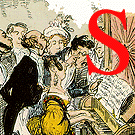 cholars and antiquarians did not seriously study Irish antiquities until the early nineteenth century. The years from 1830 to the late 1840s were a period of great cultural activity in Ireland. George Petrie, an antiquarian, was one of the most important figures of the period. Petrie became a member of the Royal Irish Academy in 1825 and helped to organize its museum collection. Two of the museum's most famous antiquities were the Tara Brooch found in 1850 and acquired by the Academy in 1868 and the Ardagh Chalice from the same period, also acquired in 1868. The forms and ornamentation of both these pieces were much imitated in Celtic Revival metalwork.
cholars and antiquarians did not seriously study Irish antiquities until the early nineteenth century. The years from 1830 to the late 1840s were a period of great cultural activity in Ireland. George Petrie, an antiquarian, was one of the most important figures of the period. Petrie became a member of the Royal Irish Academy in 1825 and helped to organize its museum collection. Two of the museum's most famous antiquities were the Tara Brooch found in 1850 and acquired by the Academy in 1868 and the Ardagh Chalice from the same period, also acquired in 1868. The forms and ornamentation of both these pieces were much imitated in Celtic Revival metalwork.
Popular national emblems such as the shamrock, the harp, the Irish wolfhound and the round tower were used exuberantly in the applied arts rather than in the fine arts. By the middle of the nineteenth century Irish motifs and symbolism had become pervasive in the work of stonecarvers, makers of furniture and souvenirs in bog oak and jewelers producing reproductions of Celtic ornaments.


Left: Copy of Royal Tara Brooch. Right: Celtic Revival brooch. Both designed and manufactured by Waterhouse and Company, Dublin in the 1850s.
The area of popular and applied art in which antiquarian studies had the most profound effect was in the making of jewelry. Institutions such as the Royal Irish Academy were instrumental in collecting and making known these ancient Celtic ornaments. Dublin jewelers began to make copies and imitations. In 1849 the Royal Irish Academy allowed Waterhouse to make drawings and copies of antique brooches in its collection, which led to manufacture on a large-scale. By 1853 their range included the Clarendon Brooch, the Royal Tara Brooch, the Knights of Templar Brooch, the Dublin University Brooch and the Innisfallen Brooch. The Tara Brooch was considered the most elaborate and beautiful of brooches and became especially fashionable. Many brooches were made in imitation of the Tara Brooch, but others featured Irish architectural antiquities such as castles and abbeys. The Ulster Museum has a brooch of bog oak from 1850 which shows Erin playing her harp while sitting on a bank studded with little gold shamrocks.
In addition to brooches, ornamented bracelets and necklaces were also popular. One of the Goggin firms in Dublin made bracelets and necklaces of "Irish diamonds" set in silver shamrock shapes. In 1851 Waterhouse and Co. designed the "Tara Bracelet" of gilt silver to complement the Royal Tara Brooches based on the ancient brooch.
The artists of Celtic Ireland and Aglo-Saxon England mingled motifs and forms that had long been evolving into a style of decorative art designated as "Hiberno-Saxon" to denote the Irish-English islands where it was produced under the auspices of the Irish church. The design elements of the nomadic and migration craft art is summed up in the exquisite Tara brooch, an article of Irish costume jewelry from the 8th century. The functional bronze ring and pin of the brooch are embellished with panels of delicate filigree and are punctuated with studs of amber and amethyst-glass. The panels, engraved and tooled with inlays of copper, silver and gold, enclose highly refined and detailed ornamental motifs. All the decorative motifs of migration art appear here in profusion and intricacy: "Interlaced birds, animals, humanoids, strap work, scrolled bands and ribbons, whorls, knots and bosses."
Questions
1. In her introduction, Sheehy states that during this time of upsurge in national sentiment which lasted until the end of the century, leaders of thought looked to the cultural achievements of the past as a way of restoring Ireland's self-respect. In her chapter on "Popular and applied arts," Sheehy states that the national feeling which inspired the revival was not a separatist national feeling. Surprisingly, she cites "loyalty, even servility, to the Crown" as "the usual thing, at least among the tradesmen in the souvenir business" (71). According to Sheehy, Waterhouse of Dublin was especially proud of the fact that Queen Victoria bought two copies of the Royal Tara brooch. Was the revival separate from politics?
2. Were Catholics or Protestants more involved in the Celtic Revival?
3. If the purpose of art was to proclaim Irishness with recognizably Irish symbols, whose Irishness was it proclaiming?
4. Was there any branch of the arts strong enough for a common style to emerge which could be recognized as universal expression of Irish nationality?
Related Materials
References
Sheehy, Jeanne. The Rediscovery of Ireland's Past: The Celtic Revival 1830-1930. Thames and Hudson, London: 1980.
Tansey, Richard G. and Fred S. Kleiner. Gardner's Art Through the Ages 10th ed. New York: Harcourt Brace, 1996.
Last modified 8 January 2024